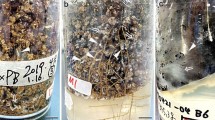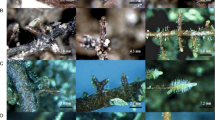Abstract
We established an in vitro ectomycorrhizal symbiosis between Tricholoma matsutake and Pinus densiflora. Mycorrhiza formed in a substrate of Modified Norkrans' C medium and granite-based soil had features similar to those observed previously only in naturally occurring mycorrhizal system called ‘shiro,’ and promoted the growth of plants with smaller root/shoot ratios. The in vitro formation of ‘shiro’ is essential for the development of T. matsutake system to produce mushrooms and is useful for the propagation and plantation of the mycorrhizal seedlings.

Similar content being viewed by others
References
Abuzinadah RA, Finlay RD, Read DJ (1986) The role of proteins in the nitrogen nutrition of ectomycorrhizal plants. II. Utilization of protein by mycorrhizal plants of Pinus contorta. New Phytol 103:495–506
Agerer R (1987–1998) Colour atlas of ectomycorrhizae 1th–11th del. Einhorn-Verlag, Munich
Bending GD, Read DJ (1995) The structure and function of the vegetative mycelium of ectomycorrhizal plants. V. The foraging behaviour of ectomycorrhizal mycelium and the translocation of nutrient from exploited organic matter. New Phytol 130:401–409
Björkman E (1942) Über die Bedingungen der Mykorrhizabildung bei Kiefer und Fichte (On the conditions for the formation of mycorrhiza in pine and spruce). Symb Bot Ups 4:1–190
Brundrett M, Bougher N, Dell B, Grove T, Malajczuk N (1996) Working with mycorrhizas in forestry and agriculture (Chap. 4.3: Measuring root colonisation by mycorrhizal fungi, pp 184–193.). Australian Centre for International Agricultural Research, Canberra, Australia
Colpaert JV, van Assche JA, Luijtens K (1992) The growth of the extramatrical mycelium of ectomycorrhizal fungi and the growth response of Pinus sylvestris L. New Phytol 120:127–135
Danell E (2002) Current research on chantharelle cultivation in Sweden. In: Hall I, Wang Y, Danell E, Zambonelii A (eds) Edible mycorrhizal mushrooms and their cultivation, Crop & Food Research, Christchurch, New Zealand, pp 1–4
Gill WM, Guerin-Laguette A, Lapeyrie F, Suzuki K (2000) Matsutake—morphological evidences of ectomycorrhiza formation between Tricholoma matsutake and host roots in a pure Pinus densiflora forest stand. New Phytol 147:381–388
Guerin-Laguette A, Conventi S, Ruiz G, Plassard C, Mousan D (2003a) The ectomycorrhizal symbiosis between Lactarius deliciosus and Pinus sylvestris in forest soil samples: symbiotic efficiency and development on roots of a rDNA internal transcribed spacer-selected isolate of L. deliciosus. Mycorrhiza 13:17–25
Guerin-Laguette A, Shindo K, Matsushita N, Suzuki K, Lapeyrie F (2004) Mycorrhizal fungus Tricholoma matsutake stimulates Pinus densiflora seedling growth in vitro. Mycorrhiza 14:397–400
Guerin-Laguette A, Vaario LM, Gill WM, Lapeyrie F, Matsushita N, Suzuki K (2000) Rapid in vitro ectomycorrhizal infection on Pinus densiflora roots by Tricholoma matsutake. Mycoscience 41:389–393
Guerin-Laguette A, Vaario LM, Matsushita N, Shindo K, Suzuki K, Lapeyrie F (2003b) Growth stimulation of Shiro-like, mycorrhiza forming, mycelium of Tricholoma matsutake on solid substrates by non-ionic surfactants or vegetable oil. Mycol Prog 2:37–44
Hamada M (1950) Physiology and ecology of Armillaria matsutake. Bot Mag Tokyo 63:741–742
Hosford D, Pilz D, Molina R, Amaranthus M (1997) Ecology and management of the commercially harvested American Matsutake mushrooms. USDA Forest Service PNW-GTR-412, pp 1–68
Jumpponen A, Trappe JM (1998) Performance of Pinus contorta inoculated with two strains of root endophytic fungus, Phialocephala fortinii: effects of synthesis system and glucose concentration. Can J Bot 76:1205–1213
Lefevre CK, Müller WR (1998) Description code 18: Tricholoma magnivelare (Peck) Readhead + Pinus contorta Dougl. var. latifolia Engelm. In: Goodman DM, Durall DM, Trofymow JA, Berch S (eds) Concise descriptions of North American ectomycorrhizaze. Mycologue, Sydney, Canada
Masui K (1927) A study of the ectotrophic mycorrhizas of woody plants. Mem Coll Sci Univ Kyoto B III 2:152–279
Marx DH (1969) The influence of ectotrophic mycorrhizal fungi on the resistance of pine roots to pathogenic infection: I. Antagonism of mycorrhizal fungi to root pathogenic fungi and soil bacteria. Phytopathology 59:153–163
Molina R, Palmer JG (1982)Isolation, maintenance, and pure culture manipulation of ectomycorrhizal fungi. In: Schenck NC (ed)Method and principles of mycorrhizal research. APS Press, St. Paul, MN, pp. 115–129
Murata H, Babasaki K, Yamada A (2004) Highly polymorphic DNA markers to specify strains of the ectomycorrhizal basidiomycete Tricholoma matsutake based on σ marY1 , the long terminal repeat of gypsy-type retroelement marY1. Mycorrhiza 15:179–186
Ogawa M (1978) The biology of matsutake (in Japanese). Tsukiji-shokan, Tokyo
Pacioni G, Comandini O (1999) Tuber. In: Cairney JWG, Chambers SM (eds) Ectomycorrhizal fungi—key genera profile. Springer, Berlin Heidelberg New York, pp 163–186
Peterson RL, Chakravarty P (1991) Technique in synthesizing ectomycorrhiza. In: Norris JR, Read DJ, Varma AK (eds) Method in microbiology, vol 23. Academic, London, pp 75–106
Smith SE, Read DJ (1997) Mycorrhizal symbiosis, 2nd ed. Academic Press, San Diego, pp. 1–605
Turnbull MH, Goodall R, Stewart GR (1995) The impact of mycorrhizal colonization upon nitrogen source utilization and metabolism in seedlings of Eucalyptus grandis Hill ex Maiden and Eucalyptus maculata Hook. Plant Cell Environ 18:1386–1394
Vaario LM, Guerin-Laguette A, Matsushita N, Suzuki K, Lapeyrie F (2002) Saprobic potential of Tricholoma matsutake: growth over pine bark treated with surfactants. Mycorrhiza 12:1–5
Wang Y, Hall IR, Evans LA (1997) Ectomycorrhizal fungi with edible fruiting bodies 1. Tricholoma matsutake and related fungi. Econ Bot 51:311–327
Yamada A, Kanekawa S, Ohmasa M (1999a) Ectomycorrhiza formation of Tricholoma matsutake on Pinus densiflora. Mycoscience 40:193–198
Yamada A, Maeda K, Ohmasa M (1999b) Ectomycorrhiza formation of Tricholoma matsutake isolates on seedlings of Pinus densiflora in vitro. Mycoscience 40:455–463
Yamada A, Kobayashi H, Murata H (2003) Tricholoma matsutake IFO6933 and IFO30604, “matsutake” isolates that have been maintained on slants and widely used in vitro for a quarter to half a century, can form ectomycorrhiza in Pinus densiflora. Mycoscience 44:249–251
Acknowledgements
This work was supported by grants from Shinshu University, Ibaraki prefecture, and the Ministry of Agriculture, Forestry, and Fisheries of Japan.
Author information
Authors and Affiliations
Corresponding author
Rights and permissions
About this article
Cite this article
Yamada, A., Maeda, K., Kobayashi, H. et al. Ectomycorrhizal symbiosis in vitro between Tricholoma matsutake and Pinus densiflora seedlings that resembles naturally occurring ‘shiro’. Mycorrhiza 16, 111–116 (2006). https://doi.org/10.1007/s00572-005-0021-x
Received:
Accepted:
Published:
Issue Date:
DOI: https://doi.org/10.1007/s00572-005-0021-x




